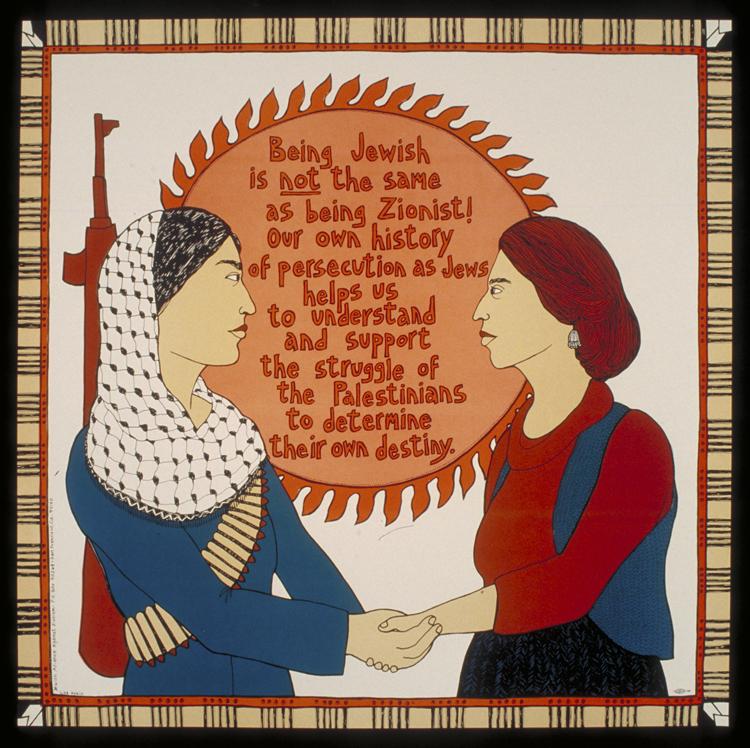Being Jewish is not the same as being Zionist! Our own history of persecution as Jews helps us to understand and support the struggle of the Palestinians to determine their own destiny.
Teachers: This poster and the following essay are meant to be used in tandem with Young Judaea as part of The New Curriculum which is designed to encourage greater student participation in classroom discussions on political Zionism, Palestinian nationalism and U.S. Middle East policy.
In this poster, published by the Jewish Alliance Against Zionism (JAAZ) we see two women standing face-to-face holding each other's hands. The woman on the left is Palestinian. She is armed with a bandolier of bullets and a military rifle signifying that the Palestinians are still in the revolutionary phase of their national liberation movement. She wears a kaffiyeh (Arabic: cotton headdress) that, prior to the emergence of the armed struggle phase of Palestinian history, was exclusively a man's garment. The adoption of the kaffiyeh by Palestinian women is an indication of the prominent, and evolving, role they play in the liberation movement.
The woman on the right is Jewish-American. She is unarmed. She does not wear any politically-charged clothing item nor does she have on any Zionist insignia. She is not wearing anything blue or white, the ideological colors of Zionism and Israel. Rather, she wears distinctly civilian attire, unadorned and utterly non-descript. She is distinctly secular. The choice of understated dress and demeanor are meant to reinforce the powerful, indeed, within political Zionist circles heretical, challenge to Zionist ideology found in the first sentence: "Being Jewish is not the same as being Zionist!"
The two women are exactly the same height, they look each other squarely in the eye, and they hold each other's hands firmly, even affectionately. This poster is a call to Jewish-Americans to engage in a person-to-person dialog with Palestinians, one that is outside of, and therefore dissenting from, the claims and rhetoric of organized political Zionism.
The remaining text marshals the full weight of Jewish history to the side of the artist and the Jewish-Americans who published this poster. JAAZ appropriates for its own purposes—to publicly abjure from organized American Zionism's conflation of Zionism with Judaism—Judaism's long and painful history of persecution. The Jewish-American woman in the poster represents that segment of American Jewry which adamantly refuses to identify with the principles of political Zionism and which wishes instead to establish an independent, mutually respectful discourse with the Palestinians.
The final phrase of the second sentence: "…helps us to understand and support the struggle of the Palestinians to determine their own destiny" is an echo of a very similar claim made by Theodor Herzl in the name of the Jewish people. This is a profoundly subversive poster in the Zionist context for a number of reasons. One is that it publicly challenges several core ideological myths that political Zionism has invested heavily in, such as that Zionism and Judaism are the same thing. Another is that all Jewish individuals and communities are obligated to live in Israel, support Zionism and take a hostile stance against those branded as critics of Zionism or opponents of Israel. Perhaps the most powerful anti-Zionist dissent embodied in this poster is the one that calls into question the legitimacy of Zionism's mythic claims to Jewish sovereignty in historic Palestine which, simultaneously, bestows legitimacy to the aims, and claims, of the indigenous Palestinian national liberation movement.
When viewed in tandem with Young Judaea, these two posters offer insights not available by viewing them in isolation. Consider that the Jewish-American figures in Young Judaea are reaching out for and, metaphorically, identifying most closely with Israel and Zionism. The message is that aliya (Hebrew: “ascension” or permanent resettlement in Israel) is the highest purpose of Jewish-American life. In "Being Jewish", by contrast, the Jewish-American woman is reaching out to a Palestinian woman—the purported existential nemesis of the three Zionist figures in the Young Judaea poster. The publication of this poster demonstrates that the Jewish-American community is not monolithic and is not in thrall to organized Zionism. Not even on questions related to Israel. The "take home" message of Young Judaea is: to be fully Jewish you must liberate yourself from your exile and return to Israel. The "take home" message of Being Jewish is: to be fully Jewish you must liberate yourself from the xenophobia and particularism of Zionism.
Published more than thirty years ago, in 1978, many if not all of the issues and controversies touched upon by this poster remain relevant, contentious and unresolved. DJW

